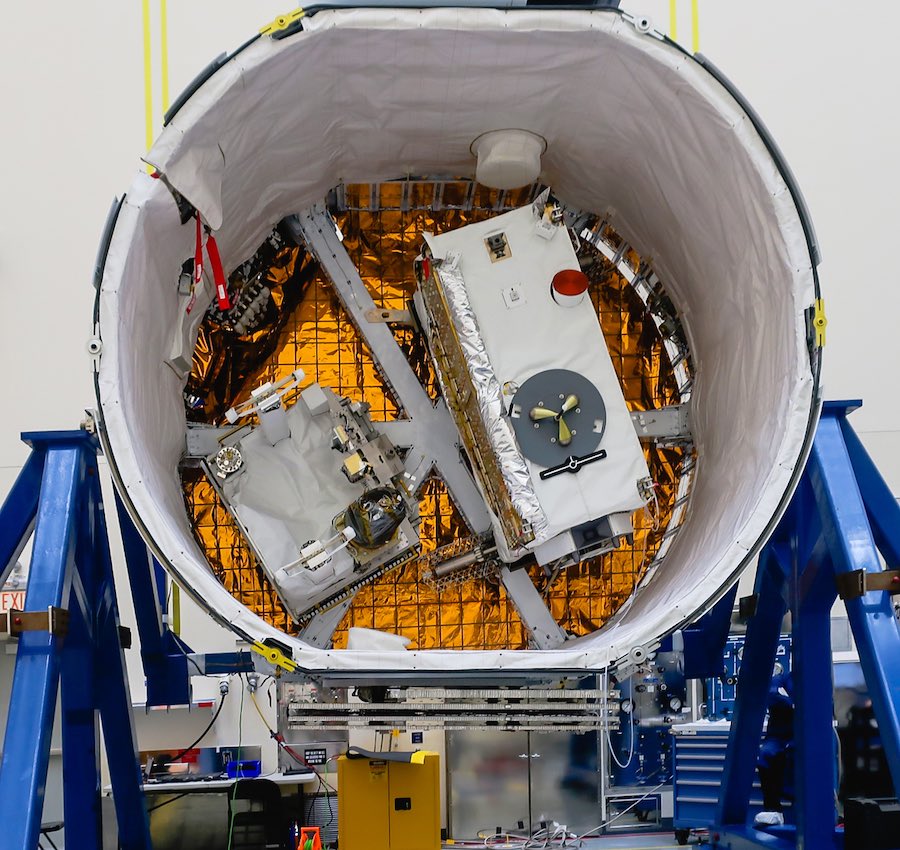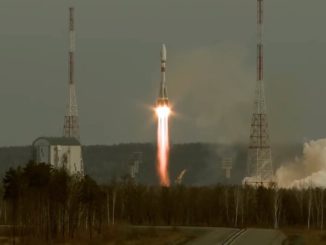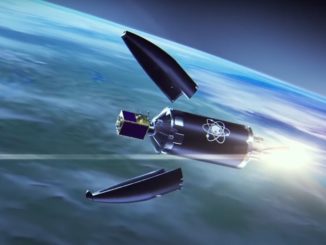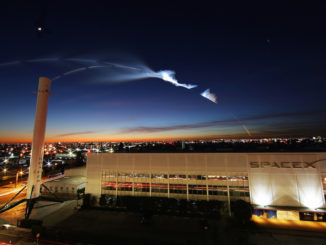
A week after a test-firing of SpaceX’s new crew capsule went awry, SpaceX successfully completed a hold-down firing of its next Falcon 9 launcher Saturday morning at Cape Canaveral in preparation for a predawn liftoff Wednesday carrying several tons of food, supplies and experiments to the International Space Station.
The Falcon 9 rocket, without its Dragon cargo capsule, ignited nine Merlin 1D first stage engines at 10 a.m. EDT (1400 GMT) Saturday, sending a plume of exhaust into the air as the kerosene-fueled powerplants ramped up to full throttle, producing 1.7 million pounds of thrust.
SpaceX confirmed a good test in a tweet soon after the hold-down firing.
Hold-down restraints kept the Falcon 9 rocket firmly on the ground during the test, which lasted several seconds. SpaceX will lower the Falcon 9 rocket at the Complex 40 launch pad and return it to a nearby hangar for attachment with the Dragon spacecraft, which is being reused after a previous trip to the space station.
The Falcon 9 and return will roll back to the pad next week in preparation for liftoff Wednesday, May 1, at 3:59 a.m. EDT (0759 GMT), roughly the moment Earth’s rotation brings the launch pad under the space station’s orbital plane.
SpaceX plans to land the Falcon 9’s first stage on a drone ship in the Atlantic Ocean approximately 17 miles (28 kilometers) southeast of the launch pad, or due east from the easternmost point of Cape Canaveral.
SpaceX’s Landing Zone 1, a former Atlas launch pad at Cape Canaveral Air Force Station, was the site of the April 20 explosion of a Crew Dragon spacecraft during ground testing. Investigators and ground teams are safing the site after the accident, and collecting evidence to help determine the cause of the mishap, which dealt a major setback to the commercial crew capsule program developed in partnership between SpaceX and NASA.
The accident prompted SpaceX to move the landing of the rocket on the next Falcon 9 launch from the onshore facility to the offshore drone ship. Resupply missions to the space station do not require all of the Falcon 9’s lift capacity, leaving enough fuel in the first stage to reverse course and return to Cape Canaveral, so the drone ship will be positioned just off the coast, not the more typical distance of several hundred miles downrange.
NASA and SpaceX officials are assessing whether last weekend’s accident may raise any concerns about the next Dragon resupply mission, according to members of NASA’s Aerospace Safety Advisory Panel. But the Dragon cargo craft is much different from the Crew Dragon, and the accident April 20 occurred during a hotfire test of the crew capsule’s SuperDraco abort engines, which are not used on Dragon spacecraft set for liftoff next week.
SpaceX is pressing ahead with preparations for Wednesday’s launch, but the Crew Dragon accident could again be discussed by senior managers during a launch readiness review planned for Tuesday.
The mission was previously slated for liftoff Tuesday, following a test-firing of the Falcon 9’s engines Friday. But the static fire was delayed to Saturday for unspecified reasons — SpaceX does not usually discuss the timing of pre-launch hotfire tests before they are completed — forcing a one-day delay in the launch to Wednesday.
A forecast issued Friday by the U.S. Air Force’s 45th Weather Squadron predicted an 80 percent probability of favorable weather conditions for a predawn launch Wednesday.

Assuming the Falcon 9 takes off Wednesday, the Dragon supply ship is due to reach the space station early Saturday. The station astronauts will grapple the Dragon cargo freighter using the orbiting lab’s Canadian-built robotic arm, then move the supply ship to a berthing port for a stay planned to last around one month.
While astronauts unpack the food, provisions and biological experiments carried inside Dragon’s pressurized compartment, robotic arms outside the station will retrieve a pair of instrument packages to be mounted on science decks outside the complex.
One of the experiments, developed by NASA’s Jet Propulsion Laboratory, will measure the amount of carbon dioxide in Earth’s atmosphere over a three-year mission. Scientists want to extend a record of space-based carbon dioxide measurements begun in 2014 by NASA’s Orbiting Carbon Observatory satellite mission, which has exceeded its design life.
Another external unit inside Dragon managed by the U.S. military’s Space Test Program hosts several investigations, including a novel X-ray communications experiment developed by NASA and the Naval Research Laboratory. X-ray signals could provide a new way to communicate with deep space probes or hypersonic missiles in flight, according to scientists.
Wednesday’s launch will be SpaceX’s fifth mission of the year, and the fifth launch overall from Cape Canaveral so far in 2019.
Email the author.
Follow Stephen Clark on Twitter: @StephenClark1.



